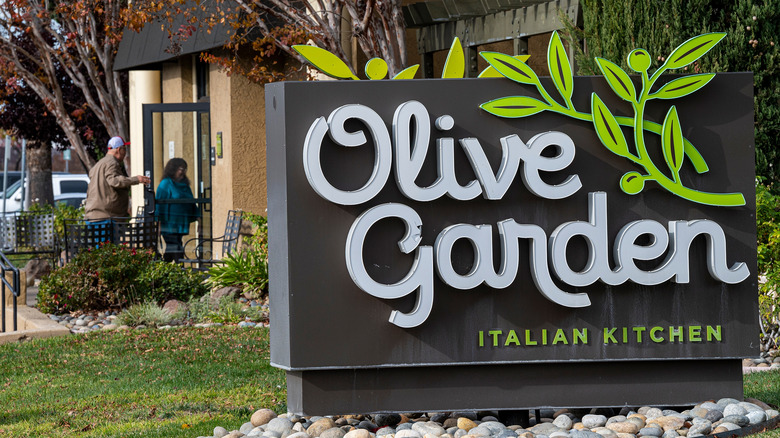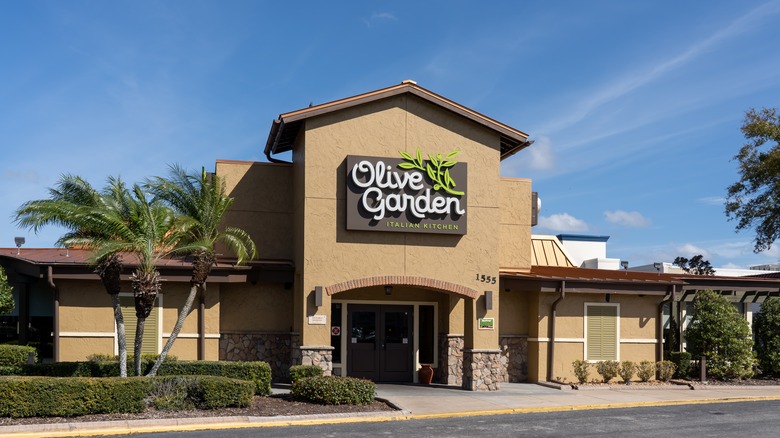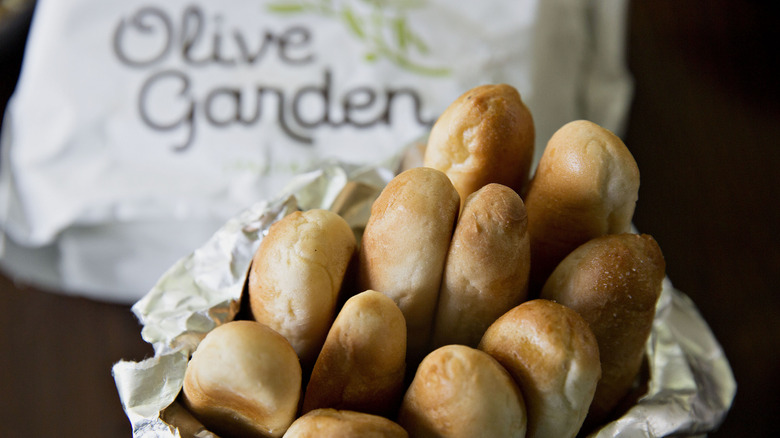The Original Olive Garden Design Was Inspired By A Farmhouse
Have you ever found yourself surrounded by endless baskets of breadsticks? Or eating chicken parmesan to the tune of classic jazz? Have you ever wanted to go on a tour of Italy without ever actually leaving the country? If any of these questions apply to you, there's only one restaurant where these things can and could happen: Olive Garden.
The story of Olive Garden begins back in 1982 as a product of the General Mills company (yes, that General Mills, the one responsible for the box of Cheerios in your kitchen cabinet). As Nation's Restaurant News explains, General Mills decided to take a crack at the restaurant industry following the acquisition of other restaurants like Red Lobster and Good Earth. Olive Garden's success was almost immediate, with the restaurant growing up to 145 locations by 1989. Today, the chain boasts an impressive 894 locations across the United States (via ScrapeHero), showcasing the chain's success in its field of Italian-American cuisine.
Now, while anyone can tell you that Olive Garden isn't exactly authentic Italian cuisine (via Food Network), the chain has done everything it can to invoke the feeling of enjoying a delicious meal with a warm and welcoming family — similar to most Italian dinners. After all, who can really complain about endless breadsticks, soup, and salad? In fact, Olive Garden's original design was even designed to give you the feeling of walking into a cozy, rustic restaurant out in the Italian countryside.
Olive Garden was designed after a Tuscan farmhouse
While a farmhouse design sounds like something more up Cracker Barrel's alley, Olive Garden was at one point designed after a rustic farmhouse. Similar to Cracker Barrel's use of architecture to immerse people in an atmosphere of old-country America, Olive Garden sought to give customers the feeling of the rural Italian countryside. According to a 2011 article from Eater, Olive Garden's original design was based on a Tuscan farmhouse, similar to the ones that dot the country all across Italy. These designs also include several aesthetic changes, such as Cypress trees, wood paneling, and columns.
Oddly enough, it was around this same year that several Olive Gardens were due to get a complete redesign, similar to their original Tuscan-themed design. As PR Newswire explains, over half of all Olive Gardens received an extreme makeover to better reflect its Italian inspirations, including everything from Tuscan-themed masonry on the front doors to an overhaul of the dining spaces and bar.
Only a few years later, Olive Garden once again underwent a major redesign (via Insider). In 2014, the chain shed its image of Tuscan farmhouses in favor of a more contemporary interior, with brighter colors, open-air dining, and a variety of "energy-bringing" fabrics and textures. This meant in the span of only three or four years, guests were eating their tour of Italy in two completely different restaurants.
Does Olive Garden actually uphold Italian tradition
Now, Olive Garden isn't exactly the most authentic Italian place there is — and that's okay! Many restaurants across America sell Italian cuisine despite not being "authentically" Italian and for the most part, they're all still good. Just because it's not straight from Italy doesn't mean it's not any good or worth trying. But is Olive Garden truly "in touch" with its Italian roots, or is all the Italy stuff just a cheap part of the marketing?
According to CNN, Olive Garden actually operates a culinary institute for the purpose of teaching Tuscan cooking. The cooking school, which has been in operation since 1999, is located at a place called "Riserva di Fizzano," which is a type of bed-and-breakfast where Olive Garden chefs stay while they study and train on different cooking techniques. Only a select few of these chefs — about an average of 100 individuals — are lucky enough to spend 11 weeks during the winter season at this institute, learning the various secrets of what goes on in Olive Garden's kitchens.
Time elaborates that this isn't some kind of intensive cooking academy, but more or less a "training seminar" where chefs go, brush up on their skills, and expand their knowledge. It's much more like a work vacation than any sort of rigorous boot camp on which types of cheese are best in your stuffed shells or making homemade pasta.
While the school may be just for training, the trip to Italy no doubt helps to inspire chefs on different flavors of the Italian palette.


